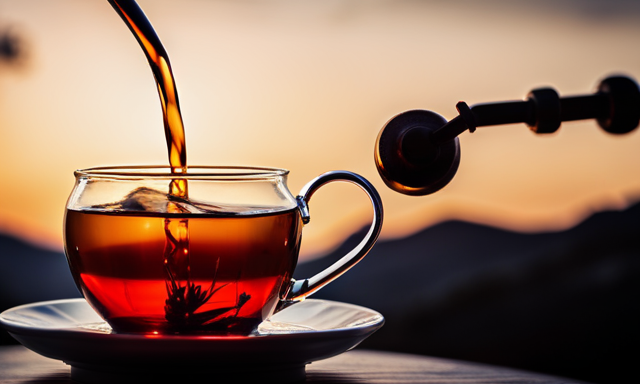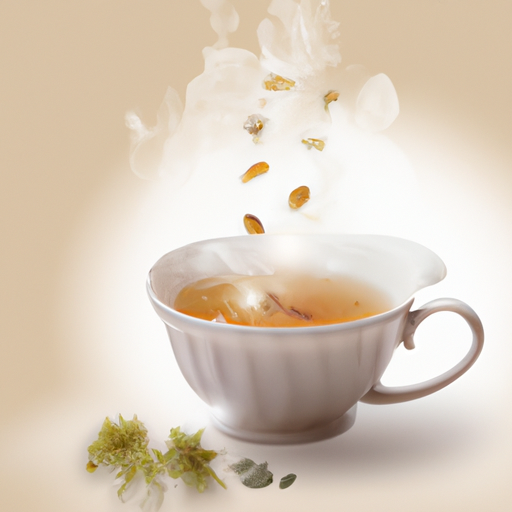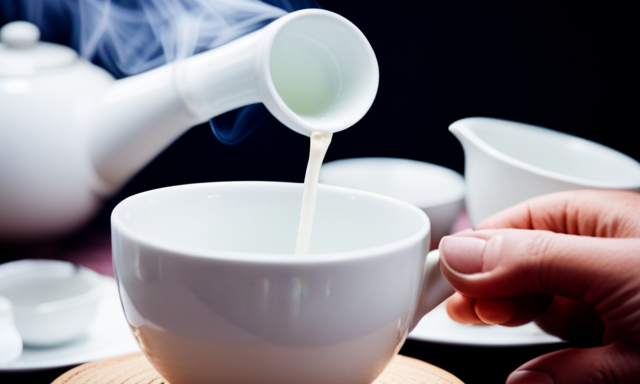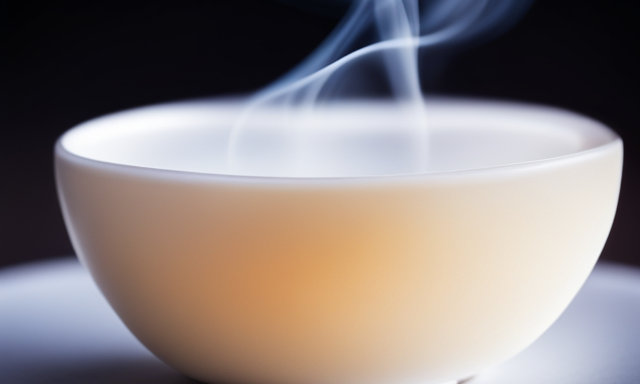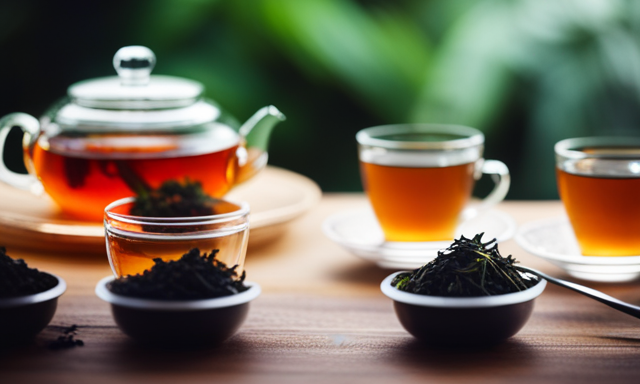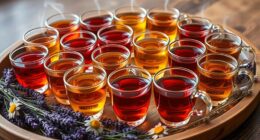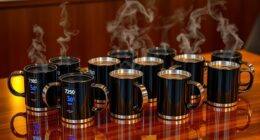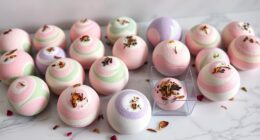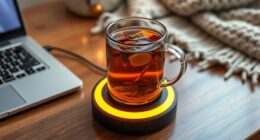Brewing oolong tea is an art form that requires patience, precision, and a deep understanding of the tea leaves themselves. In this article, I will guide you through the steps of brewing the perfect cup of oolong tea, sharing my knowledge and expertise along the way.
First and foremost, it is important to choose the right tea leaves for brewing oolong tea. Look for high-quality loose leaf oolong tea that is fresh and fragrant. Avoid tea bags, as they often contain lower quality tea leaves that may not yield the best flavor.
Once you have your tea leaves, it’s time to measure the proper tea to water ratio. A general guideline is to use one teaspoon of tea leaves for every 8 ounces of water. However, you can adjust this ratio based on your personal preference for a stronger or milder flavor.
Next, heat the water to the optimal temperature for brewing oolong tea. Unlike other types of tea, oolong tea requires water that is not boiling but rather around 180-200°F (82-93°C). Boiling water can scorch the delicate leaves and result in a bitter taste.
Once the water has reached the desired temperature, it’s time to steep the tea. Place the tea leaves in a teapot or infuser and pour the hot water over them. Allow the tea to steep for about 3-5 minutes, or longer if you prefer a stronger flavor. Keep in mind that oolong tea can be steeped multiple times, with each steeping revealing different layers of flavor.
After the desired steeping time, remove the tea leaves from the water to prevent over-extraction. You can use a strainer or simply pour the tea through a fine-mesh sieve into your cup.
Finally, take a moment to appreciate the aroma and color of your freshly brewed oolong tea. Each sip will reveal a complex flavor profile, with notes of floral, fruity, and sometimes even toasty or nutty undertones.
In conclusion, brewing oolong tea is a meticulous process that requires attention to detail and a respect for the tea leaves. By choosing high-quality tea leaves, measuring the proper tea to water ratio, heating the water to the optimal temperature, and steeping the tea for the right amount of time, you can unlock the full flavor and aroma of oolong tea. So, sit back, relax, and enjoy a cup of this exquisite beverage.
Key Takeaways
- Using a Gaiwan enhances the taste of oolong tea by allowing control of brewing time and temperature, resulting in a balanced and flavorful cup.
- Straining tea to remove leaves is an essential step after brewing, ensuring a clean and enjoyable drinking experience and allowing flavors to flow freely into the cup.
- Reusing tea leaves for additional infusions is a great way to maximize the flavor and value of oolong tea, storing used leaves in an airtight container and refrigerating until the next brewing session.
- Choosing the best oolong tea for taste involves considering the oxidation level, origin, and processing techniques, as there is a wide variety of options available ranging from light and floral to dark and robust.
Choose the Right Oolong Tea Leaves
Choosing the right oolong tea leaves will make your taste buds dance with delight as you savor every sip.
When it comes to oolong tea, there are various flavor profiles to explore, from floral and fruity to nutty and roasted. Each flavor profile is achieved through different processing techniques and tea leaf qualities.
Understanding the importance of tea leaf quality is crucial in selecting the perfect oolong tea. Look for leaves that are tightly rolled, with vibrant colors and a fresh aroma. High-quality oolong tea leaves will unfurl beautifully during brewing, releasing their complex flavors and enticing aromas.
Once you have chosen the right leaves, it’s time to move on to the next step: measuring the proper tea to water ratio, ensuring the perfect balance of flavors in every cup.
Measure the Proper Tea to Water Ratio
To ensure a perfectly balanced cup, you’ll want to get the tea to water ratio just right – remember, ‘a watched pot never boils.’ When it comes to brewing oolong tea, the ratio is crucial for extracting the delicate flavors. The general rule of thumb is to use 1 teaspoon of tea leaves for every 8 ounces of water. However, this can vary depending on personal preference and the specific oolong tea you’re using. To help you visualize, here’s a table that outlines the recommended tea to water ratios for different oolong teas:
| Oolong Tea Type | Tea Leaves (in grams) | Water (in ml) |
|---|---|---|
| Light Oolong | 3-5 | 240 |
| Medium Oolong | 5-7 | 240 |
| Dark Oolong | 7-9 | 240 |
| Aged Oolong | 9-12 | 240 |
| Flavored Oolong | 4-6 | 240 |
By measuring the proper tea to water ratio, you can bring out the best flavors in your oolong tea. Now, let’s move on to the next step: heating the water to the optimal temperature.
Heat the Water to the Optimal Temperature
Now, you’ll want to heat your water to the perfect temperature for extracting the full flavors of your oolong infusion. Achieving the optimal water temperature is crucial for brewing the best cup of oolong tea. Here are three brewing techniques to help you get it just right:
-
Boiling Water Method: Bring the water to a rolling boil and then let it cool for a minute or two before pouring it over your oolong tea leaves. This method works well for darker oolong teas.
-
Off-Boil Method: Heat the water until it reaches about 195°F (90°C). This temperature is ideal for medium-roasted oolong teas, allowing them to release their delicate flavors without becoming bitter.
-
Cool Water Method: Use water that is around 175°F (80°C) for lightly roasted or green oolong teas. This lower temperature preserves the tea’s subtle nuances and prevents it from becoming overly astringent.
Now that your water is at the optimal temperature, it’s time to preheat your teapot or teacup for the next step.
Preheat Your Teapot or Teacup
First things first, make sure you’ve got your teapot or teacup ready by preheating it for the ultimate tea experience. Preheating your teapot or teacup before brewing oolong tea has several benefits. It helps to maintain the optimal temperature of the tea, prevents rapid cooling, and ensures that the flavors and aromas are fully extracted. There are different methods you can use to preheat your teapot or teacup. One method is to rinse it with hot water and let it sit for a few minutes before discarding the water. Another method is to pour boiling water into the teapot or teacup and let it sit for a minute before pouring it out. Whichever method you choose, preheating is an essential step in preparing oolong tea. Now, let’s move on to the next step and steep the tea leaves for the right amount of time.
Steep the Tea Leaves for the Right Amount of Time
To achieve the perfect cup of oolong tea, it is crucial to steep the tea leaves for the right amount of time. This allows the flavors to fully develop, creating a rich and aromatic brew. Understanding brewing time variations and the importance of water temperature is essential.
Brewing Time Variations: Different oolong teas have different steeping times. Lighter oolong teas, such as green oolong, typically require 2-3 minutes of steeping. On the other hand, darker oolong teas, like roasted oolong, may need 4-5 minutes. It is important to adjust the steeping time based on your taste preference and the specific instructions provided for the tea.
Importance of Water Temperature: The ideal water temperature for brewing oolong tea is around 195°F (90°C). Using water that is too hot can result in a bitter taste, while water that is too cool may not extract the full flavor from the tea leaves. It is crucial to find the right balance and ensure the water temperature is suitable for the specific oolong tea you are brewing.
By understanding and adjusting the brewing time and water temperature, you can consistently enjoy a perfect cup of oolong tea. Now, let’s explore the correct brewing method, whether it be gongfu style or western style.
Use the Correct Brewing Method (e.g., gongfu style or western style)
Discover the secret to achieving the perfect cup of oolong tea by mastering the art of using the correct brewing method. Whether it’s gongfu style or western style, the choice of brewing method can greatly impact the flavor and aroma of your tea.
Gongfu style, which involves multiple short infusions, is ideal for high-quality oolong teas. This method allows you to fully extract the complex flavors and aromas of the leaves, resulting in a more robust and enjoyable cup.
On the other hand, if you prefer a simpler brewing process, the western style is a great option. It involves a longer infusion time and is suitable for medium to low-grade oolong teas.
Additionally, using a gaiwan, a traditional Chinese tea brewing vessel, can enhance the taste of oolong tea. The gaiwan allows for better control of brewing time and temperature, resulting in a more balanced and flavorful cup.
Now, let’s move on to the next step: strain the tea to remove the leaves and further enhance the clarity of the brew.
Strain the Tea to Remove the Leaves
Once the brewing process is complete, strain the tea to remove the leaves. This essential step ensures a clean and enjoyable drinking experience, allowing the smooth and vibrant flavors to flow freely into your cup.
There are different types of tea strainers that you can use, such as mesh ball infusers, tea filters, or even a simple fine-mesh sieve. Choose a strainer that suits your preference and fits well with your teapot or cup.
To strain the tea, place the strainer over your teacup or teapot and pour the brewed tea through it. This will separate the leaves from the liquid, leaving you with a clear and flavorful cup of oolong tea.
After straining, don’t throw away the tea leaves just yet! You can actually reuse them for additional infusions. Oolong tea leaves are known for their ability to withstand multiple brews, each with its own unique flavor profile. Simply store the used leaves in an airtight container and refrigerate them until your next brewing session.
Now that you have strained the tea and prepared it for consumption, it’s time to pour and enjoy the aroma and flavor of oolong tea.
Pour and Enjoy the Aroma and Flavor of Oolong Tea
Pour yourself a cup of the aromatic and flavorful oolong tea, and savor each sip as the rich flavors dance on your taste buds.
Oolong tea not only offers a delightful taste experience, but also provides numerous health benefits. Studies have shown that oolong tea can help boost metabolism, aid in weight loss, improve heart health, and even lower the risk of chronic diseases.
When choosing the best oolong tea for your taste preferences, consider factors such as the tea’s oxidation level, origin, and processing techniques. Whether you prefer a light and floral oolong or a dark and robust one, there is a wide variety to choose from.
Now, as you venture into the world of oolong tea, you can also experiment with different brewing techniques and times to further enhance your tea-drinking experience.
Experiment with Different Brewing Techniques and Times
Indulge in the art of tea brewing by exploring various techniques and timings, allowing you to personalize your oolong tea experience to perfection. Here are three key tips to enhance the flavor of your oolong tea:
-
Experiment with different types of oolong tea:
From light and floral to bold and roasted, there is a wide variety of oolong teas available. Try different types to discover your preference and expand your palate. -
Adjust brewing time and temperature:
Oolong tea can be brewed at different temperatures and steeping times to bring out its unique flavors. Play around with shorter or longer brewing times and varying water temperatures to find the perfect balance for your taste. -
Use proper tea ware:
Using a clay teapot or gaiwan can enhance the flavor of oolong tea. These materials retain heat well and allow the tea leaves to unfold and release their aroma fully.
By exploring these techniques, you can unlock the full potential of oolong tea. Properly brewed oolong tea offers a delicate balance of flavors that can be enjoyed in every sip.
Now, let’s learn how to store your oolong tea properly to maintain its freshness.
Store Your Oolong Tea Properly to Maintain Freshness
To preserve the exquisite taste and aroma of your oolong tea, safeguard its freshness by storing it in an airtight container away from light and moisture. Proper storage techniques are crucial in preventing tea oxidation and ensuring a longer shelf life. When exposed to air, oolong tea can lose its flavor and become stale. Airtight containers, such as glass jars or tin cans, provide a barrier against oxygen and help maintain the tea’s freshness. Additionally, storing oolong tea away from light and moisture is essential. Sunlight and humidity can degrade the tea’s quality and lead to flavor loss. By following these storage guidelines, you can enjoy the full-bodied flavor and enticing aroma of your oolong tea for an extended period.
| Proper Storage Techniques |
|---|
| Use an airtight container |
| Store away from light |
| Keep away from moisture |
Frequently Asked Questions
What are the health benefits of drinking oolong tea?
Drinking oolong tea can promote weight loss and improve heart health. Its high antioxidant content boosts metabolism and aids in fat burning, while also reducing cholesterol levels and promoting cardiovascular well-being.
Can I reuse oolong tea leaves for multiple brews?
Yes, you can reuse oolong tea leaves for multiple brews! By adjusting steeping techniques and increasing steeping time, you can still enjoy the flavors and health benefits of oolong tea.
What is the difference between gongfu style and western style brewing?
Gongfu and Western brewing are two different techniques for preparing oolong tea. Gongfu brewing uses smaller teapots and shorter steeping times, resulting in a more concentrated and flavorful brew. Western brewing uses larger teapots and longer steeping times, producing a milder flavor. The choice between the two depends on personal preference and the desired strength of the tea.
How long can I store oolong tea before it goes bad?
You’ll want to avoid storing oolong tea for too long as it can lose its flavor and freshness over time. The general rule of thumb is to consume it within 6-12 months to ensure optimal taste.
Can I add milk or sweetener to oolong tea?
Yes, you can add milk or sweetener to oolong tea. Adding milk can give it a creamy texture, while sweetener can enhance the flavor. Experiment with different amounts to find your preferred taste.
Conclusion
In conclusion, brewing a perfect cup of oolong tea is an art that requires precision and knowledge. By following the right steps and techniques, you can unlock the full potential of this exquisite beverage.
Remember to:
- Select high-quality tea leaves
- Measure the right tea to water ratio
- Steep for the appropriate amount of time
Don’t forget to store your oolong tea properly to maintain its freshness.
So why not dive into the world of oolong tea and let its captivating flavors dance on your palate? It’s a sip worth savoring.

